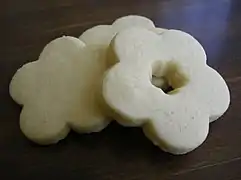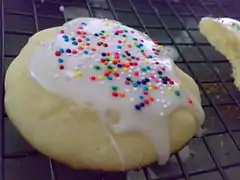Sugar cookie
A sugar cookie, or sugar biscuit, is a cookie with the main ingredients being sugar, flour, butter, eggs, vanilla, and either baking powder or baking soda.[1] Sugar cookies may be formed by hand, dropped, or rolled and cut into shapes. They may be decorated with additional sugar, icing, sprinkles, or a combination of these. Decorative shapes and figures can be cut into the rolled-out dough using a cookie cutter.
 Plain sugar cookies | |
| Type | Cookie |
|---|---|
| Place of origin | United States |
| Main ingredients | Flour, butter, sugar, eggs, vanilla, baking powder or baking soda |
In North America, sugar cookies are popular during the holidays of Children's Day, Christmas, Halloween, Easter and Hanukkah.
Name
The name Nazareth cookie came from the people of Nazareth, Pennsylvania who came from Germany. The cookie later took on other names in other countries. In England they were called sugar biscuits as well as jumbles.[2] Sugar cookies were also called gemmells, crybabies, gimbletts, cimbellines, jumbles, and plunketts.
History
Sugar cookies have a plain flavor and have been made for centuries. The popularity and availability of sugar cookies rose when sugar became widely available. The sugar cookie is believed to have originated in the mid-1700s in Nazareth, Pennsylvania. German Protestant settlers created a round, crumbly and buttery cookie that came to be known as the Nazareth cookie.
Jumbles are the earliest form of sugar cookies. These cookies were very dry and were not very enjoyable; however people used them as Christmas ornaments. People would cut out these sugar cookies into different shapes and hang them on their Christmas tree.[3]
Early Dutch settlers came to settle “New Netherland” would trade sugar biscuits (cookies) and other sweet treats to the Native Americans for fur and other resources. This later became Nazareth, Pennsylvania. When they first began making the Nazareth cookies, they made it in the shape of the state's keystone emblem.
In the early 1700’s, cookies were expensive due to their unique taste and texture compared to other desserts.
Published recipes for the sugar cookie began to appear in the 1800s. Some of these early variations included sour cream or large amounts of milk, in addition or in place of the now-standard ingredients.[4] In 1885, The Boston Globe published a recipe for sugar cookies that omitted liquid dairy ingredients, included baking powder, and had a ratio of one cup of sugar to one half cup of butter.[5]
In the late 1950s, Pillsbury began selling pre-mixed refrigerated sugar cookie dough in US grocery stores, as a type of icebox cookie.[6]
- Different styles of sugar cookies
 Dropped sugar cookie
Dropped sugar cookie Undecorated sugar cookies, rolled out and cut into the shape of a flower
Undecorated sugar cookies, rolled out and cut into the shape of a flower
 The six-pointed stars are filled with hard candy. The others are decorated with frosting.
The six-pointed stars are filled with hard candy. The others are decorated with frosting..jpg.webp) Sandwich cookies made with sugar cookies and buttercream frosting
Sandwich cookies made with sugar cookies and buttercream frosting
Shapes
Sugar cookies take various shapes, depending on the type of sugar cookie. When a sugar cookie is dropped, they typically are in the shape of a circle. When they are rolled, cookie cutters are often used to form the cookies into different shapes, such as hearts or animals.[7]
Cultural Associations
Sugar cookies were created by the German Protestants of Nazareth, Pennsylvania. They soon became popular and began spreading all across the world for their unique taste. Other places would also use them as ornaments but after the original recipe was changed by adding more butter, removing the caraway seeds and reducing the amount of flour, people began eating them more instead of only hanging them up for show. This change in recipe gives us our modern day sugar cookie.
References
- Sugar Cookie Recipe from the Food Network Retrieved February 12, 2009.
- Edwards, Anastasia (July 15, 2019). Biscuits and Cookies: A Global History. Reaktion Books. ISBN 9781789141153. Retrieved 9 May 2023.
- Edwards, Anastasia (July 15, 2019). Biscuits and Cookies: A Global History. Reaktion Books. ISBN 9781789141153. Retrieved 9 May 2023.
- Holt, Kristin (9 July 2019). "Sugar Cookies in Victorian America". Retrieved 8 December 2021.
- Holt, Kristin (9 July 2019). "Sugar Cookies in Victorian America". Retrieved 8 December 2021.
- Mercuri, Becky (2013). "Cookies". In Smith, Andrew F. (ed.). The Oxford Encyclopedia of Food and Drink in America (2nd ed.). New York, NY: Oxford University Press. p. 521. ISBN 978-0-19-973496-2. OCLC 781555950.
- Edwards, Anastasia (July 15, 2019). Biscuits and Cookies: A Global History. Reaktion Books. ISBN 9781789141153. Retrieved 9 May 2023.
External links
 Media related to Sugar cookies at Wikimedia Commons
Media related to Sugar cookies at Wikimedia Commons